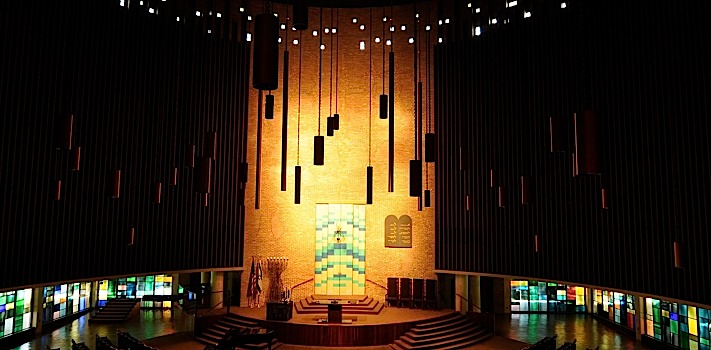Temple EmanuEl
Completed in 1957, the Temple EmanuEl became the largest, most expensive, and most detailed synagogue of Meyer’s religious architecture repertoire.
Modernism in Religious Architecture
Additionally, Kepes' commission extended to the instillation of extensive mosaic glass walls to line the walls sanctuary and converging at the ark. A playful arrangement of rectilinear geometries of the panes within their vertical restraints creates natural appeal while marinating a focus of verticality that is predominate within the domed area of the sanctuary. While the verticality emphasized by Kepes’ glass mosaic piece appeals to geometric tendancies, the hue and chromatic patterning of the glass wall derives its origins from the organic and the spiritual nature of the sanctuary. The prevalence of greens, blues, golds, and reds are arranged in a nature that creates a dappled effect reminiscent of the light diffusion technique employed by the surrounding shady grove. With tonal range varying greatly from dark to light in differing colors, Kepes continues along with subtle motif of the connecting nature with the religious experience. In sentiment to the religious context of the piece, Kepes’ implementation of the increasing intensity of hue as well as vibrancy evokes of the glass panes conveys a sense of growth and journey with a focus on eventual enlightenment. Consequently, the symbolic nature of the instillation by Kepes intensifies not only by conveying a sense of religious journey and enlightenment, but also an essential element to heighten the exquisite architecture detail of the interior.
As illumination plays a distinctive role with creating the profoundly religious nature of the sanctuary, Kepes implemented, in accordance to the punctured and direct use of daylighting by Howard Meyer through his diffused “chandler”, illustrated that the use of central lighting needed not to be in a concentrated form, but instead created forty-four pendent lighting fixtures to create an intimate glow throughout the sanctuary. Whereas Meyer’s punctured, small window implements are organic luminary tactic, Kepes’ inventive use of different length tubes of light and at different heights allows for a dynamic lighting feature that takes on a sculptural nature.
Contributing to the collaborative nature of Temple EmanuEl through experts in a variety of artistic and technical fields, Kepes brought in Anni Albers, a foremost weaver of the United States, to aid in the development of the distinctive aesthetic of Temple EmanuEl. Heightening the dichotomous relationship of the organic and religious within the sanctuary of Temple EmanuEl, Albers created an intricate woven set of doors to house the ark. The chromatic scheme and arrangement of the geometric patterning devices by Albers evokes the essence attained by Kepes’ exquisite mosaic windowed planes.
Sources: Christol, G. (1998). A Light in the Prarie: Temple EmanuEl of Dallas 1872-1992. Ft. Worth: Texas Christian University. Preservation Dallas, & The Dallas Architecture Forum. (1997, November). Howard Meyer: Temple Emanu-El and Other Works. Dallas: Preservation Dallas.


